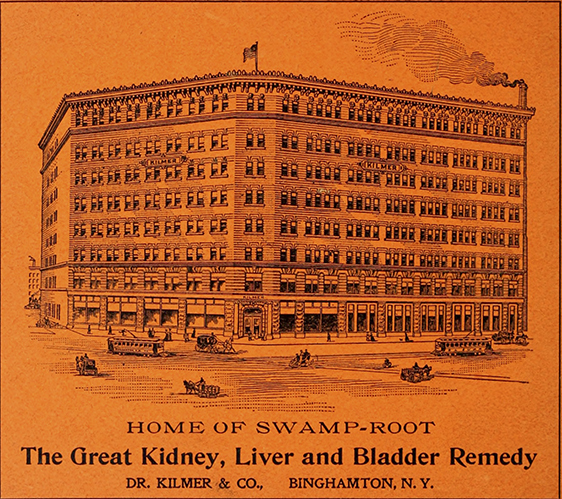Student Digital Exhibits from
HIST 480K: Binghamton’s Business (Spring 2018)
How has Binghamton been shaped by capitalism – and how has Binghamton shaped capitalism?
Deeply, it turns out; and in many different ways. As these diverse exhibits showcasing the stories of the Binghamton area demonstrate, the Parlor City isn’t just home to spiedies and shoe factories: when it comes to capitalism, Binghamton’s past is as interestingly complicated as America's itself. In disparate domains – advertising quack medicine, distributing seeds, conspicuously consuming Gilded Age architecture, caning food in wartime, deflecting blame for attacking striking miners, or following through on the promise of a Square Deal – Binghamton and Binghamtonians have been intimately involved in the conflicts and continuities that have defined the American experience of capitalism.
Each of the following exhibits was created by a student in HIST 480K: Binghamton’s Business (Spring 2018 edition). They present the results of semester-long research projects, independent work that students completed while making weekly tours of public history sites, doing service work in local archives and museums, and participating in weekly discussions of historiography and historical sources. Through all these efforts, the class collectively investigated Binghamton’s past as a case study for the history of capitalism, probing how the city and its surroundings have been shaped by currents of economic development, from Binghamton's origins in the settler-colonialism of the late 18th century through to the challenges of deindustrialization in the 21st.
As you peruse this site, we hope you’ll join us in investigating Binghamton’s past as a means to understand the history and culture of American capitalism – and in using that history to inform conversations about its future.
List of Exhibits
Thanks and acknowledgments
Student projects were developed in conversation with Broome County’s local historians and archivists, and rely upon the digital and physical holdings of the institutions they steward, including the Broome County Historical Society, Binghamton University Special Collections, the Bundy Museum of History & Art, the Vestal Museum, and the George F. Johnson Memorial Library, among others. Students presented draft posters of these exhibits at an extraordinarily successful local history conference (Perspectives: Broome County Area History Conference), organized by Andrew Pragacz and Diania Gildea, and hosted by the Bundy Museum of History & Art. Special thanks to Yvonne Deligato, Gerald Smith, Cherese Rosales, Chelsea Gibson, and Andrew Pragacz for lending their aid and professional expertise to the work of advising student projects and overseeing their research. and a big thank you to David Schuster and Amy Gay for implementing and supporting the technology that makes this Omeka site possible.
I would also like to express my personal appreciation to Yvonne Deligato (Binghamton University), Gerald Smith (Broome County Historical Society), Andrew Pragacz (Binghamton University), Janna Rudler (Bundy Museum), Cherese Wiesner-Rosales (Vestal Museum), Kevin Wright (Binghamton University, Past2Future Project), Jennifer Dorsey (Sienna College), Rachel Blaifeder (Binghamton University), Diana Gildea (Binghamton University), Ravi Palat (Binghamton University), Wendy Wall (Binghamton University), Valerie Imbruce (Binghamton University), Diane Miller Sommerville (Binghamton University), Jonathan Karp (Binghamton University), Heather DeHaan (Bingahmton University), Elizabeth Casteen (Binghamton University), Catherine McNeur (Portland State University), Monica Mercado (Colgate University), David Wittner (Utica College), Benjamin Schmidt (Northeastern University), and Dan Bouk (Colgate University), for their advice and conversation on local history, digital humanities, course design and course materials.
Finally: the development of this course was made possible by a course release provided by the Institute for Advanced Studies in the Humanities at Binghamton University in Fall 2017. My thanks to Bat-Ami Bar On (IASH Director), Wendy Wall (IASH Associate Director), Kierstin Luschwitz (IASH Secretary), and Heather DeHaan (Chair of the History Department) for enabling this grant.
~ Prof. Dael Norwood, May 2018
